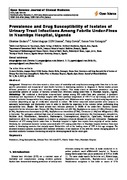| dc.description.abstract | Background: Urinary tract infections remain a silent cause of morbidity and complications among under-fives due to its nonspecific presentation and incapacity of most health facilities in developing countries to diagnose it. Earlier studies present
different prevalence of urinary tract infections among children. This study aimed to document prevalence and drug susceptibility patterns of isolates of bacterial urinary tract infections among under-fives in Nsambya hospital, Uganda.
Methodology: We conducted a descriptive cross-sectional survey among 302 under-fives who presented in paediatric
ambulatory care department of Nsambya hospital with fever (axillary temperature of >37.5°C or by history); and with no
history of antibiotic therapy within three days preceding hospital visit. Midstream urine samples collected using bag and bottle
collection (depending on age of child) were subjected to culture. We further subjected culture-positive urine samples to
systematic bacteriologic and biochemical tests in order to identify the organisms in the colonies before performing drug
susceptibility tests. Results: We found urinary tract infection prevalent in 26.8% of the under-fives. Bacterial isolates
responsible for the infections were Proteus (39.5%), Escherichia coli (32.1%), Staphylococcus aureus (14.8%), Klebsiella spp.
(6.2%), Staphylococcus haemolyticus (2.5%), Staphylococcus intermedius (2.5%), Citrobacter (1.2%) and Morganella (1.2%)
in that order. The pathogens exhibited high-level of resistance to commonly used antibiotics like Cotrimoxazole, Amoxicillin,
Nalidixic Acid, Nitrofurantoin, Gentamicin, Erythromycin, Chloramphenicol, Ampicillin, Ciproflaxin, Tetracycline and
Azithromicin while the isolates showed no resistance to pharmaco-enhanced Amoxicillin and oral Cefatoxime. Conclusion:
Prevalence of UTI among febrile under-fives in Nsambya hospital is higher than reports from majority of earlier studies.
Similarly, the commonest bacterial isolates associated with UTI among under-fives in Nsambya hospital deviates from most
studies in developing countries that majorly report Escherichia coli as the leading cause of UTI in this age category. The
observed resistance patterns associated with common antibiotics in our study are in line with the current changing patterns of
microbial-antibiotic resistance threatening not only the developing world but the entire glob. | en_US |


